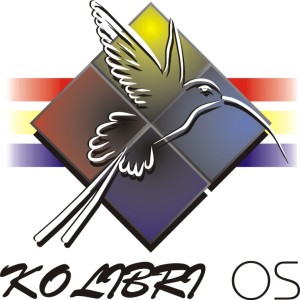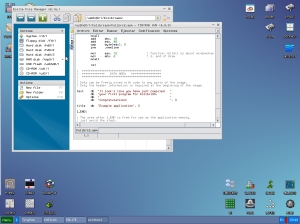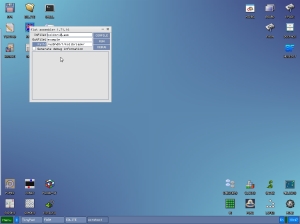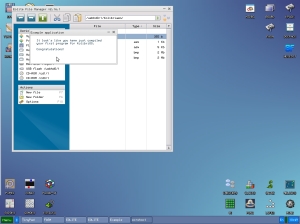Como ya sabeis desde liberad a linux (o gnu/linux) llevamos un pequeño tiempo dedicandonos a los sistemas operativos (libres) alternativos, pues hoy os traemos un tutorial para comenzar a desarrollar aplicaciones sobre y para Kolibri OS.
Para empezar necesitaremos :
– PC con Kolibri OS instalado o live.
– Yo use la versión 0.7.7 de Kolibri OS (La recomiendo)
– Un USB para pasar los archivos a Kolibri OS.
Manos a la obra :
Antes de nada aclarar que este codigo esta escrito en Ensamblador que se compilará sobre Kolibri OS con FASM, y que este tutorial es el primero de muchos.
Esta aplicacion simplemente creará una ventana que contendra un titulo y un mensaje, la aplicación compilada ocupa 355BYTES.
Codigo fuente de la aplicación : (Abajo en zip no lo copieis)
;;;;;;;;;;;;;;;;;;;;;;;;;;;;;;;;;;;;;;;;;;;;;;;;;;;;
; ;
; EXAMPLE APPLICATION ;
; ;
; Compile with FASM ;
; ;
;;;;;;;;;;;;;;;;;;;;;;;;;;;;;;;;;;;;;;;;;;;;;;;;;;;;
format binary as «» ; Binary file format without extenstion
use32 ; Tell compiler to use 32 bit instructions
org 0x0 ; the base address of code, always 0x0
; The header
db ‘MENUET01’
dd 0x01
dd START
dd I_END
dd 0x100000
dd 0x7fff0
dd 0, 0
; The code area
include ‘macros.inc’
START: ; start of execution
call draw_window ; draw the window
; After the window is drawn, it’s practical to have the main loop.
; Events are distributed from here.
event_wait:
mov eax, 10 ; function 10 : wait until event
mcall ; event type is returned in eax
cmp eax, 1 ; Event redraw request ?
je red ; Expl.: there has been activity on screen and
; parts of the applications has to be redrawn.
cmp eax, 2 ; Event key in buffer ?
je key ; Expl.: User has pressed a key while the
; app is at the top of the window stack.
cmp eax, 3 ; Event button in buffer ?
je button ; Expl.: User has pressed one of the
; applications buttons.
jmp event_wait
; The next section reads the event and processes data.
red: ; Redraw event handler
call draw_window ; We call the window_draw function and
jmp event_wait ; jump back to event_wait
key: ; Keypress event handler
mov eax, 2 ; The key is returned in ah. The key must be
mcall ; read and cleared from the system queue.
jmp event_wait ; Just read the key, ignore it and jump to event_wait.
button: ; Buttonpress event handler
mov eax,17 ; The button number defined in window_draw
mcall ; is returned to ah.
cmp ah,1 ; button id=1 ?
jne noclose
mov eax,-1 ; Function -1 : close this program
mcall
noclose:
jmp event_wait ; This is for ignored events, useful at development
; *********************************************
; ****** WINDOW DEFINITIONS AND DRAW ********
; *********************************************
;
; The static window parts are drawn in this function. The window canvas can
; be accessed later from any parts of this code (thread) for displaying
; processes or recorded data, for example.
;
; The static parts *must* be placed within the fn 12 , ebx = 1 and ebx = 2.
draw_window:
mov eax, 12 ; function 12: tell os about windowdraw
mov ebx, 1 ; 1, start of draw
mcall
mov eax, 0 ; function 0 : define and draw window
mov ebx, 100 * 65536 + 300 ; [x start] *65536 + [x size]
mov ecx, 100 * 65536 + 120 ; [y start] *65536 + [y size]
mov edx, 0x14ffffff ; color of work area RRGGBB
; 0x02000000 = window type 4 (fixed size, skinned window)
mov esi, 0x808899ff ; color of grab bar RRGGBB
; 0x80000000 = color glide
mov edi, title
mcall
mov ebx, 25 * 65536 + 35 ; draw info text with function 4
mov ecx, 0x224466
mov edx, text
mov esi, 40
mov eax, 4
.newline: ; text from the DATA AREA
mcall
add ebx, 10
add edx, 40
cmp byte[edx], 0
jne .newline
mov eax, 12 ; function 12:tell os about windowdraw
mov ebx, 2 ; 2, end of draw
mcall
ret
; *********************************************
; ************* DATA AREA *****************
; *********************************************
;
; Data can be freely mixed with code to any parts of the image.
; Only the header information is required at the beginning of the image.
text db «It look’s like you have just compiled »
db «your first program for KolibriOS. »
db » »
db «Congratulations! «, 0
title db «Example application», 0
I_END:
; The area after I_END is free for use as the application memory,
; just avoid the stack.
;
; Application memory structure, according to the used header, 1 Mb.
;
; 0x00000 – Start of compiled image
; I_END – End of compiled image
;
; + Free for use in the application
;
; 0x7ff00 – Start of stack area
; 0x7fff0 – End of stack area – defined in the header
;
; + Free for use in the application
;
; 0xFFFFF – End of freely useable memory – defined in the header
;
; All of the the areas can be modified within the application with a
; direct reference.
; For example, mov [0x80000],byte 1 moves a byte above the stack area.
Yo se lo costoso que es copiar el codigo de la web y por eso lo teneis AQUI en un zip – Pincha AQUI.
Captura del codigo fuente con un editor de texto de kolibri.
2 – Tenemos que compilarlo para ello en la parte superior derecha del entorno de escritorio encontraremos FASM (Compilador de ensamblador libre) Lo pinchamos en uno de los cuadros introducciremos nuestro source (Ejemplo : programa.asm) El ejecutable que queremos que nos de (Ejemplo : example) y la ruta donde estan y se almacenarán dichos archivos. (Ejemplo /rd0/1/) y pulsamos compilar :
FASM a punto de compilar.
Y ya tan solo nos falta ejecutar el programa :
Ejecutando el programa.
Un ultimo detalle en el zip teneis el codigo fuente, el ejecutable (Por si lo quereis) y las capturas que realicé desde Kolibri OS y que podeis ver desde el mismo como ayuda.
Esto es todo espero que os haya gustado y si necesitais algo comentad que conestaremos.






muchas gracias, genial lo tuyo
Hola. Me gustó mucho el tutorial. Me gustaría hacer más cosas con este sistema operativo. Como por ejemplo poder controlar una base de datos, imprimir listados de número insertandolo aleatoriamente y luego ordenarlo.
Te quiero hacer una pregunta. ¿Puedo traducir todo los mensajes y comentarios? Y luego compilar. 😎